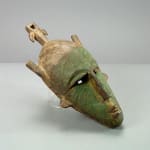Marka Mask Covered with Metal Plaques, 20th Century CE
Wood and Metal
12
PF.6123
Further images
The Marka, also known as the Warka, belong to the Soninke people whose original settlements in Ghana date back as far as 750 A.D. However, conflicts with the Berbers forced...
The Marka, also known as the Warka, belong to the Soninke people whose original settlements in Ghana date back as far as 750 A.D. However, conflicts with the Berbers forced the Soninke to disperse throughout neighboring regions. The Marka people now occupy the part of Mali north of the Bambara territory westward to the Senegalese border. Both the Bambara and Bozo tribes heavily influenced their social organization and cult practices. The Marka are famous for their masks and puppets. Similar to Bambara's Ntomo society masks, Marka masks are generally carved with horns, comb or crest on top of the head, but unlike Bambara masks they are often covered with metal sheeting. Marka ceremonial masks are further characterized by their elongated faces, pointed chins, and long angular noses. The Marka dress their masks in brightly colored costumes made of cloth that both enliven the work of art as well as disguise the identity of the dancer. This mask features two truncated horns on either side of the mask. These horns may relate to the antelope, a creature that was worshipped as an agricultural deity. A small crest crowns the central peak of the mask. This odd protrusion seemingly functions as a square-shaped hook and is embellished with two downward curving horns that recall the silhouette of a ram or water buffalo. Typical of the Marka style, this mask is covered in thin layers of metal that enliven the mask with texture and color. Although the characteristics of this mask suggest that it was carved by the Marka, it is quite possible that this mask was created along a border region separating the Marka from the Bambara. Clearly, this mask reveals the close stylistic similarities that unite these two unique tribes in a common artistic heritage.







